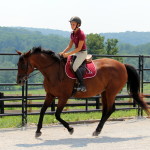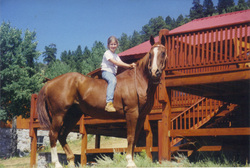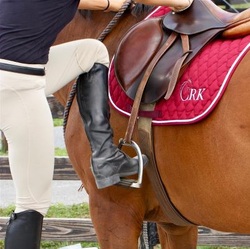I have had many requests for a video on riding the canter, so here it is! The canter may well be one of the most enjoyable gaits – there is enough speed to be exhilarating, but on a balanced horse the canter is smooth and comfortable. The canter should have a “rocking horse” motion to it, and the number one tip for riding it is to relax and allow your body to just go with the motion.
If you are just learning to canter, the ease of your learning will depend greatly on the horse you ride. A horse who is able to canter balanced and slowly without assistance from his rider will make learning to ride this gait much easier. If your horse has a fast, unbalanced canter you, as a rider, will struggle to find your own balance and fear can take over if you start to feel out of control. Also, horse’s tend to escalate more quickly at the canter if they are nervous or unsure because the faster gait will increase adrenaline in an already reactive horse. So be safe, and if your own horse is difficult at the canter and you are new at it, I would recommend finding a local barn where you can take lessons on a good school horse to build both your confidence and your familiarity with the movement of the canter.
In this video, I will show how to ride a canter with both a deep seat and with a “half seat.” I also chose to use a horse with a big stride, so you can see my more exaggerated movement! Click play to watch the video, enjoy, and leave a comment with your thoughts or questions! Thanks!














34 Responses
I thoroughly enjoy watching your videos. Thank you, Thank you for generously sharing your time, energy, knowledge and skills.
As always, thank you for taking the time! You are an amazing teacher……
Hi Callie,
Thanks so much for this wonderful video. It nicely reinforces the info from the balanced riding course. Fantastic teaching, as always!
Hi Margaret,
That is great! I actually added a new canter video to the course that I felt improved on the last one, so check that out when you have a chance!
Callie….. THANK YOU..! Great video and I get it.. specialty when you said about the too heavy seat makes her hotter.. and yes it does now I know why. Always a pleasure watching your videos thanks
Hi Tammy! Glad you liked the video!
Thank you so much Callie, you really help me to understand riding. For the canter, your way of breaking it into the full seat and half seat is extremely enlightening. Excellent!
Callie, I enjoy reading your blog and watching your videos. Thank you for your generous sharing of your vast equestrian knowledge! It has helped me be a more conscious rider!
Thank you fron downunder Australia for your very informative instructional videos! Having come back to riding/owning a horse after a 20 year break, I have found the canter a real issue – very frustrating. Mind over matter and much practise in the arena. It will come…
Hi Linda, Glad you are enjoying the videos! Thanks for watching from Australia!
Hi Callie, I am a new comer to your website. I love your clarification about not sitting deep and driving the horse during the canter but should be sitting tall and moving your seat along with the movement of your horse. Very insightful and useful tip for a 61 year old new rider like me. Thank you very much!
Glad you enjoyed it!
Hi Callie
thank you so much for the video, i started learning riding 2 months ago at riding school and every time i do the canter i feel scared and unable to make more than 1 round , what is happening i start grabbing my knees up so my feet going out of the stirrup , i appreciate if you can tell me more tips how the knees should be and the legs
thanks
Hi, thanks for your comment! Think about letting your knees go forward and down. This well help keep your legs under you and help you keep your balance in the saddle.
Hey!
I’m just now learning how to ride the canter, and I am riding a horse who has a big stride (just like the horse in the video). It is hard to keep my balance on her because of this, and my legs keep moving around. Her canter is a little bit scary, she “nods” her head around a a lot. I feel like I’m behind her motion. What can I do to help my problems?
Hi Julia,
Try riding without your stirrups at the canter. I realize this probably sounds scary, but figuring out how to let your seat follow your horse’s motion is the key to being stable at the canter and with the motion of the horse. Again, if you have anyone who can lunge your horse as you do this it will probably feel safer 🙂
Hi Callie,
Enjoyed watching you canter in this video ~ I am just learning the canter and have problems with my hands when I initially pick up the canter- I tend to pull back and raise my hands; I think because I am not yet used to the feeling of the canter. Can you give me any tips ? As always thanks for another great video.
Hi Nancy,
One idea is to use a neck ring (or a simple string around your horse’s neck). Hold on to this string as you pick up the canter. This will prevent you from accidentally pulling the horse’s mouth (which makes the canter immediatly more difficult to ride as the horse throws their head up) and will help you be more aware of when you are actually lifting your hands. If you make that string short enough it will help force your body to learn how to get that “swing” with the canter, separating your hands from the movement of your seat. Hope this is helpful! Callie
Callie ~ you make the canter look so easy!! one of these days I am going to get it, but I am still not quite there. I watch this video every week before my lesson and find it helpful. Nancy
Hi Callie
I really enjoyed watching this video. I am just learning to canter. When ever i canter i feel like i am going to fall off especially when i am going around a corner. My teacher always tells me to grip with my knees but then my heels aren’t down in the stirrups. Last week when i cantered i fell off because i was holding on to the saddle to tight. Do u have any tips? Thank you so much fort the awesome videos!!
Hi Katie,
The only way to really effecitively learn to canter is to ride by balancing on your seat and not gripping with your legs. When you sit in the saddle, you want to feel three points of contact – your two “sit” bones and what is called your “pubic symphysis”. This creates a triangular region that is your pelvic floor. When you are on these three points with your lower back fairly straight (women have some natural curvature) then your seat is balanced. At the canter, imagine feeling your hips this way and simply following the movement of the saddle with your hips. I am going to be making a video to illustrate this in a few days so just keep watching for that!
dear Callie, I really enjoy watching your video and have to admit that many times I just get back to all of them to remind myself on some of your advices
I am particulary interested at this one where I focus my thoughts on your very quiet position of feet even if you ride canter.That is something that I really often bothering. I just cannot control my so always “flying feet ” and keep them under control. with heels down or not , knees pressed or not against saddle …. I have allready tryed all but does not work.
Could you be so kind to give me some advices how to improve this skill?
thank you in advance!
Someone actually put this idea in the comments under another video and I think it is a great visualization: imagine your feet “skiing” in the sand. Picture that your feet have to stay relatively level for you to remain balanced and upright. If your toes get grabby and point down, they will stick in the sand and throw you forward, if your heels go too low, you will get thrown back. Hope this helps! Callie
Callie, thanks for sharing this video with us. I am new to riding and today was my 12th lesson. My instructor had me try the canter on a longe line, and it was real scary for me as I was not prepared for it and didn’t really know what to do. I tried to sit back in the saddle as deeply as I could and gripped with my legs and tried not to move much and I was so scared of falling off. Your explanation of “scooping with the hips” to ride the canter is very helpful, and also what you said about how someone trying to ride the canter should learn how to ride sitting trot first. I even mentioned to my instructor today that maybe I should learn the sitting trot before I ride the canter and that was before I had seen your video, but my instructor thought I was ready to try the canter, and I really felt that I was not quite ready at all. So I will suggest next time that I learn how to ride sitting trot first to get the concept and skill down.
Thanks Callie. The notion of “scooping with the hips” is very helpful. I learned the sitting trot first but the jump to learning the canter has been challenging and scary. With this new notion of hip movement I hope to regain some confidence and stability.
Hello Callie: have watched a number of your videos and done a few of the free online courses. This has been most helpful as have returned to riding after many years off. Am using a school horse so riding time is limited, have ridden two horses but have asked to go back to older, bigger horse. (the other one is too quick, hard to get trot let alone canter)
But today had riding lesson on Buddy and actually managed to canter for first time ever, ok held on to the saddle strap but will get more confident as time goes by.
Thank you very much for these videos, its great that you share your knowledge and wisdom regarding horse riding, management.
Cheers from Australia.
Hi Lynda, glad you have been enjoying the videos!
It’s good to know this about riding a horse at a canter. We’re looking to try and go on a horse riding trip this year, so I’m trying to learn as much as I can. If a canter is quick but comfortable, that’ll be my goal for when I try it out!
Awesome, you are going to have so much fun! I would recommend also participating in our Better Riding in 7 Days free mini course. In there you’ll find the small pieces of advice that make a huge difference for a basic position 🙂
-Julia Burdy, CRK Training Community Manager
Thankyou so much for explaining how to ride the canter without bouncing! Rolling my hips worked instantly. Thankyou!
Glad to hear it was helpful Esther!
-Julia Burdy, CRK Training Community Manager
I just finished watching Riding the Canter, It’s a Swing, Not a Scoop. Interesting to see the difference in how you are now riding the canter compared to this video. Have you noticed a difference in how you feel physically? Do you notice any difference in the horse when you switch to swing from scoop?
Yes, absolutely there is a shift in the horses! They are better able to carry the weight of the rider, plus you are more stable with a stabilized lower back!
-Julia, CRK Training Community Manager
Greetings. You look great in the saddle. Just a little confused re: seat for riding canter Is it more of a scoop or more of a swing? Can you also explain the difference between scoop vs. swing? Thank you for sharing all you know to make us better for our horses.